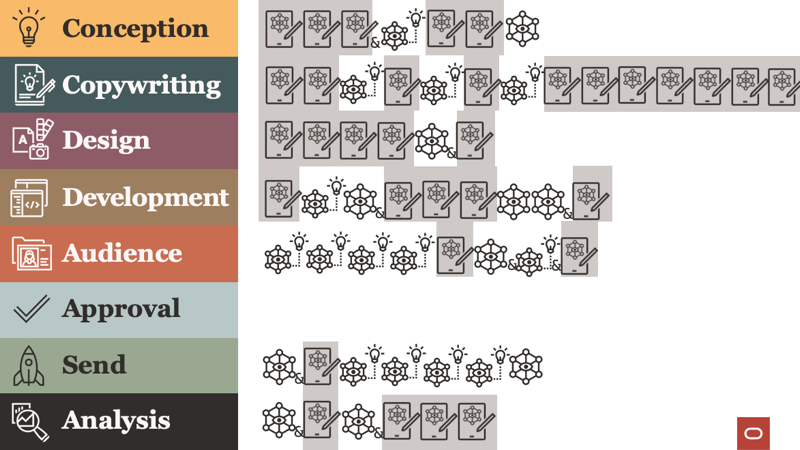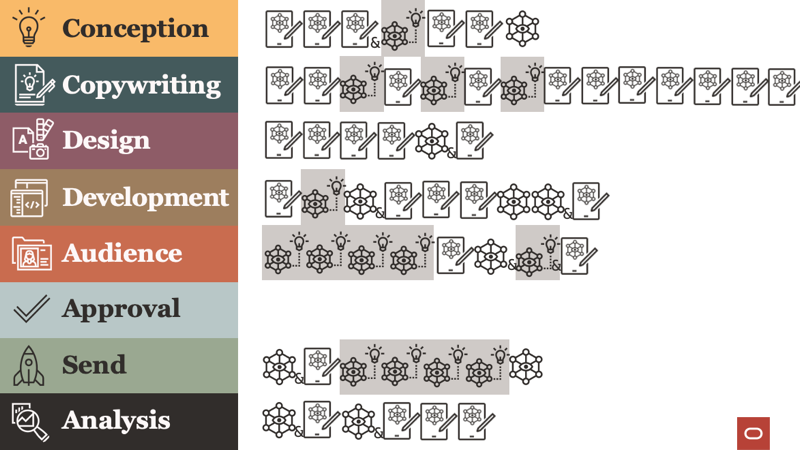Brands have been using artificial intelligence tools in their email programs for many, many years. However, the rise of generative AI is causing a reevaluation of the opportunities to use classic AI, machine learning, and generative AI throughout the eight stages of the email production process:
- Conception: Identifying the need for a campaign and defining its goal, target audience, and more
- Copywriting: Writing the messaging
- Design: Crafting the visual design of the campaign
- Development: Coding the email experience, including any interactivity
- Audience Selection: Choosing the subscribers to receive a campaign or defining the trigger for an automated campaign
- Approval: Signing off that the campaign that was created matches its initial intent and goal
- Send: Launching and monitoring the campaign
- Analysis: Examining the results of the campaign, including any A/B testing
In the 51-minute on-demand webinar below, we discuss dozens of potential opportunities for marketers to use AI during each of those email production stages. We also share some alternative frameworks for thinking about the roles of classic AI, machine learning, and generative AI, as well as talk about how AI can help brands achieve the one-to-one marketing paradigm of sending the right message to the right person at the right time via the right channel.
The Biggest Opportunities for Generative AI
Looking across those eight email production stages, we see lots of potential near-term use cases for generative AI, particularly in the first four stages, which are more creative-oriented. Caution is still very much warranted when using GenAI for copy, images, and code, but thoughtful use by experienced copywriters, designers, and coders can make these tools the strong assistants they are designed to be.

The Biggest Opportunities for Machine Learning
For machine learning, we see most of the opportunities in the Audience Selection and Send stages, with a few uses elsewhere. Unlike with GenAI, the use cases for machine learning are well-established and generally highly effective. For example, send time optimization has been considered a high-adoption, high-impact email marketing trend for years, and RFM modeling is also used by a majority of major brands.
Other machine learning tools are more niche, including subject lines optimization tools and content and product recommendation engines. However, these are also considered highly impactful email tools by our experts.

The Right AI Opportunities for Your Brand
AI tools can assist or be tasked with an ever-expanding list of roles. However, just because AI can do something doesn’t mean it should do that for your organization.
Every brand should prioritize their pain points, while also being mindful of their company culture, staff considerations, and the change management that’s necessary when any new technology is introduced to an existing process. Extra sensitivity and awareness is demanded when experimenting with or rolling out generative AI tools, since these generally impact tasks currently performed by people—in contrast to machine learning tools, which perform tasks that tend to be time-prohibitive for people to do.
Be methodical, purposeful, and goal-driven with all your email marketing process changes.
—————
Need help with your email marketing strategy? Oracle Digital Experience Agency has hundreds of marketing and communication experts ready to help Responsys, Eloqua, Unity, and other Oracle customers create stronger connections with their customers and employees—even if they’re not using an Oracle platform as the foundation of that experience. With a 94% satisfaction rate, our clients are thrilled with the award-winning work our creative, strategy, and other specialists do for them, giving us an outstanding NPS of 82.
For help overcoming your challenges or seizing your opportunities, talk to your Oracle account manager, visit us online, or email us at OracleAgency_US@Oracle.com.
To stay up to date on customer experience best practices and news, subscribe to Oracle Digital Experience Agency’s award-winning, twice-monthly newsletter. View archive and subscribe →


